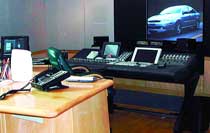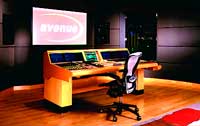THE ADVANTAGE OF MORE CHANNELS
According to Advantage Audio (www.advantageaudio.com) co-owner and president Bill Koepnick, the facility is tackling two upgrades at once, the first being a move to Pro Tools HD and the second coming as they replace their Studer D950 M2 consoles with the new Vista 7. He moved to Vista 7 for the user interface, he says. "It's a huge leap forward, It gives you so much more information and it's a much easier interface for the mixers to work on. I think it's a faster and far more intuitive."
While he'll wait until October for the new boards to arrive, he's been sitting on the HD upgrade until Digidesign delivers the back ordered DigiSnakes. The move to HD was predicated by the fact that Advantage Audio needed to pack more output channels into the same amount of physical space. "The 192 interface allows us to get as many as 32 digital channels of AES I/O on one two-rack-space unit," Koepnick explains. "The real problem is that we had these custom racks built and if we want to add more channels, the easiest way to do that is get more interfaces. We didn't want to buy older 888s and put them in there to expand, so we just traded in some of our old 888s and got the 192s. It allows us greater density in input/output."
The combo HD-Vista 7 upgrade enables the company to accomplish a number of things. For one, the tandem allows them to increase the number of channels they can use - Advantage Audio is at 48 channels now and this brings them up to 80. "All our editorial is done in Pro Tools and then we just mix straight off of Pro Tools stations," he explains. "Each of our mixing stages has four full Pro Tools systems in each one - separated out into music, dialogue, Foley and effects. Currently we have two mixing stages: one of them is set up for 5.1 and the other is just stereo. So, we're going to make the second room also 5.1 surround." By putting in identical systems, Koepnick's team will be able to push their audio-for-picture post production for television work from room to room without a concern. "Bigger projects, higher track count, better mixing environments, 5.1 in both rooms and consoles that should make things go faster and better," he summarizes.

Mike King
|
PLUNK 'EM & PLAY 'EM
Audio Recording Unlimited's co-owner Mike King added a 7TB Fairlight MediaLink Server Sound system to his Chicago-based facility to make some duties easier, including those of studio manager Betty Rake. As King explains it, Rake is one of the best at finding and delivering needle-drop music to answer client demands. Yet, because of ARU's (www.aruchicago.com) situation in the historic Wrigley Building, Rake would have to jaunt between floors to deliver the goods. "With the MediaLink, there will be a file and we'll just go get our pick list and plunk 'em and play 'em," he says. "This is like when I went from analog reel-to-reel tape editing to my first digital workstation."
Of course, the MediaLink will also help ARU organize their vast sound effects library above and beyond a search engine that was developed by Dan Bayes at Commercial Recording in Cleveland. While that system is good, King explains, it requires mixers to record the effects into a Fairlight before being able to use them. Again, speed and ease of use was the requirement, which is especially important as ARU works on Ford and Chevy dealer spots, as well as commercials for McDonald's, Allstate Insurance and Toys 'R' Us for agencies such as Needham and Leo Burnett.

Audio Recording Unlimited installed Fairlight's MediaLink server sound system along with its FAME MFX3 plus.
|
With a laugh, King points out that this upgrade was not a plug-and-play situation, and infrastructure had to be in place before the server could be installed. First off, the studio spent $19,000 to install air conditioning that will run while the building is off. Also, an independent power source was also brought in to ensure there would be no power bumps and each of the studio's Fairlight FAMEs is being networked.
Since studios bill clients by the hour, it would seem that investing to make your studio more efficient would cut down on the profits, a glaring Catch-22. Thankfully, King notes, clients are experienced enough to notice and appreciate the improvements. "I think what it really does is, from a client relation standpoint," says King, is "you look better to them if this stuff just flies into place. Also, a lot of our clients could care less. They come over, they want to do a session, they understand the steps that it takes and they don't really care. I think it will make our lives internally here a lot easier."
HELP WITH THE HOUSEKEEPING
When Vancouver's Mainframe Entertainment (www.mainframe.ca) decided to upgrade to four AMS Neve AudioFile SC units with Starnet and Media Toolbox they started from scratch. "We just ripped the other systems right out, so we didn't have to integrate them with any older stuff," explains audio supervisor Marcel Duperreault. "It was a complete rebuild." Their previous systems were Macintosh based, which became a problem once the memory started to fill. "They started wiping out and crashing, and we were in jeopardy of missing deliveries," he says. "Our turnaround is pretty quick - some shows we'd have to turn around in a couple of days."
Because of the show's frenetic pace, the Mainframe team felt like the AudioFile was the way to go. "It's just the most elegant solution," Duperreault says. "The boxes are so specific to what we do every single day. There are other boxes that people use and it's almost like you're operating with one arm behind your back." Before a decision was made on AudioFiles, they tried out both Pro Tools and Fairlights for a month. The Starnet system helps with archiving the studio's sessions, especially if a client calls back and needs to make a change.
According to Duperreault, this upgrade was done both to appease client demands and to make their job easier. "I don't want to have to think about housekeeping when doing a show. As far as the clients go, I don't want to look like a fool fumbling around on a piece of equipment."
THE ROUTE STUFF
 |
Frank Jones, owner of Castle Oaks Productions (www.castleoaksproductions.com) in Santa Monica, has been in the process of upgrading his studio for almost two years now. One of his first steps while trying to become a full service facility, where he could package services such as Foley, ADR, scoring and dubbing, was to purchase a Yamaha DME routing system. "I bought it with the intent of using it in a 5.1 post production dubbing facility," he explains. He also put in a 5.1 monitoring system, Pro Tools Mix Plus with ProControl, a Mackie digital console along with a Neve console and a pair of TASCAM MC-24s. But something happened on the way to becoming an audio post house - he started to get a number of calls for record projects. "What happened is that Pro Tools became such a thing about recording. I used to do it all analog, but now every project that comes through my door is Pro Tools. The room has become very popular with my record clients, I haven't been able to do any film work in this room. So, here my DME has been sitting, waiting to be used," he explains.
So, Jones upgraded to Pro Tools HD and is building a new room to house his record clients while he gets back to post work. He's optimistic there's demand for the services he wants to offer. "Because post production budgets are getting tighter and tighter, they are looking for a facility where they can send one sound supervisor and get it all done," he explains. "They want a fixed price. They don't want to go all over town to one facility for the Foley, one for the score, one to ADR and one to dub. Then they're moving tapes around and directors are going to different locations. They don't want that - that's wear and tear and loss of time."
As soon as Jones gets to that point, he can see the value of the DME. "The application of the DME was to monitor 5.1 and handle all my stems and do different formats," he explains. "There's a monitor matrix if I wanted to hear mono, or if I'm print mastering it would handle all these different things and route all the signals to wherever I wanted to go."

Avenue Edit upgraded its audio offerings with three new studios featuring Euphonix System 5 consoles.
|
GEARED FOR THE FUTURE
It took the Chicago-based Avenue Edit (www.avenue-edit.com) team just over two years - from taking over another 6,500 square feet of space for three other studios to completion - to complete their most recent studio upgrade. As audio engineer Cory Coken says, "We really needed to take our time, and there was no rush because we kept our two rooms up and running. We made sure everything was done right the first time."
One thing the extra time enabled them to do was wait while Euphonix finished developing the System 5 console for use in commercial post production. "We bought the Euphonix CS3000 consoles before we bought the System 5s, because when we saw the System 5s initially, they weren't ready yet," Coken says. "They didn't make it in a commercial post model yet, they only made the film size, and it was just too big. They didn't have a lot of the features that we needed. It was well worth [the wait], no patch bays need to go in the rooms because the System 5 handles that internally. It made the rooms a lot cleaner and a lot more streamlined."
The pair of System 5 consoles (which were installed along with a DSP Postation II) installed with an eye toward the future. "We wanted to get the technology to where we were ready for what was coming down the pipe with HD and 5.1 and eventually 7.1. We wanted to be prepared," Coken says. The boards were chosen for the flexibility they provided. "Our clientele doesn't know right out of the gate where we're going or what we're doing, and to have a console that's not very flexible limits what we can do and what we can't do," he says. "One minute you're mixing stereo, the next you're mixing in surround and the next they want foreign versions. With the Euphonix System 5 you can just hit a button and all that happens."